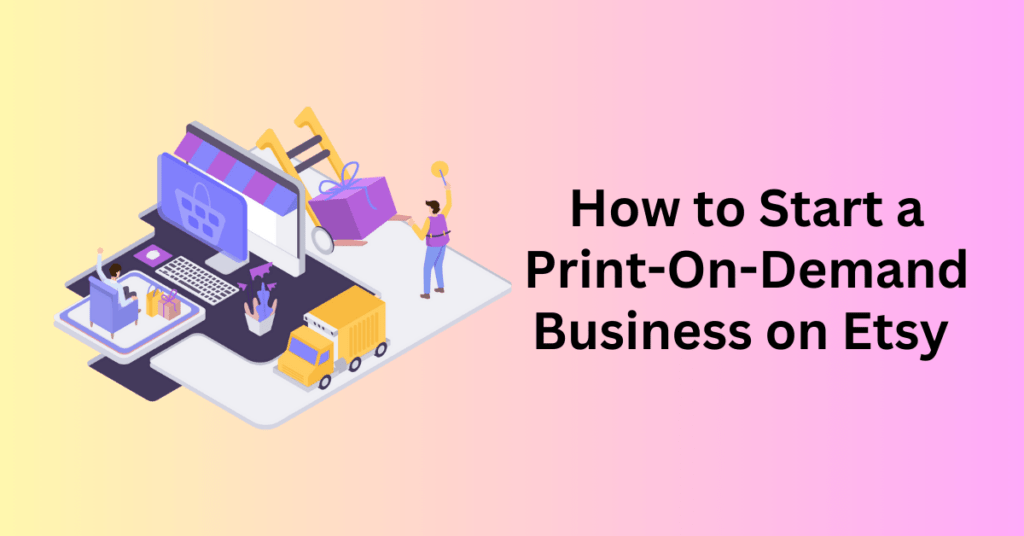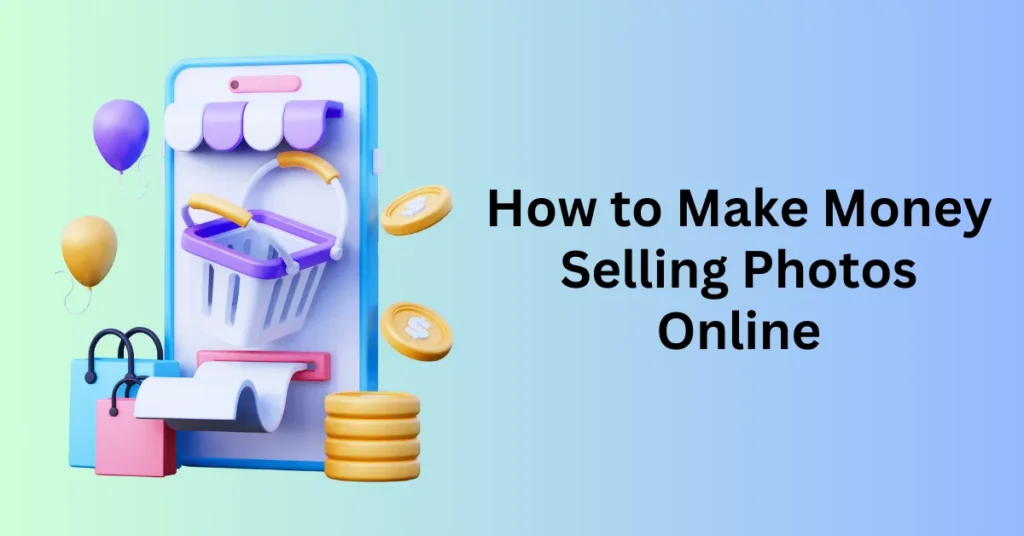If you would like to start your own business without huge upfront investment costs, a print-on-demand business on Etsy could be the perfect solution for you.
Etsy has been growing steadily for the past few years with over 90 million active buyers worldwide. And print-on-demand business model is the perfect model for anyone who wants to start their own business with ease and make money from the comfort of their home.
In this comprehensive guide, we will show you how to start an Etsy print-on-demand business step by step. We will explain what is print-on-demand with Etsy and its advantages and disadvantages.
Besides, we will also be sharing the step-by-step on how to start your Etsy store and sell online.
What Is Print on Demand?
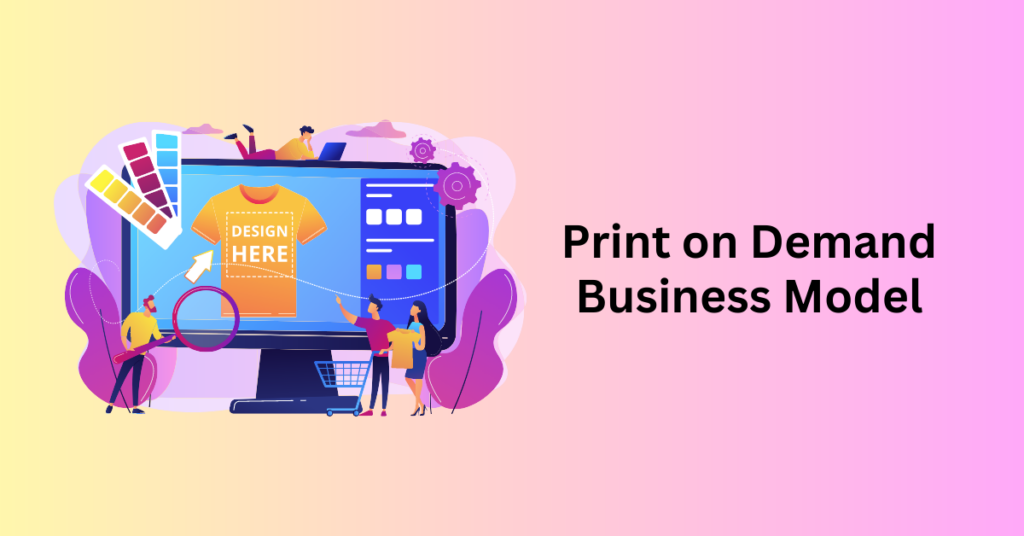
Print on Demand (PoD) is a contemporary manufacturing and fulfilment approach that has gained prominence in various industries. It allows content creators or new business owners to offer customized products without the need for large-scale production runs. This innovative method empowers individuals and businesses to create and sell unique merchandise on a per-order basis, reducing the financial risks associated with traditional manufacturing models.
How Print on Demand Works: A Summary Breakdown
Step 1: Design Creation
You start by creating the digital design for your products. It can be graphics for apparel, book covers, or artwork. These files are typically created using graphic design software and are saved in formats suitable for printing.
You can either create it by yourself or hire a freelancer or designer to do it for you.
Step 2: Choose your Print-on-demand Platform
Now that you have your designs ready, it’s time to get a Print-on-demand platform to upload your design. You can partner with PoD platforms, such as Printful, Printify, or Merch by Amazon.
Most Print-on-demand platforms are free to sign up. Sign up for a free account with them and you are good to go. Browse through their product catalogues to see the products you want to sell.
Then, upload your digital designs to the chosen platform, specifying the products you want to offer (e.g., T-shirts, mugs, or posters).
Step 3: Customer Order Placement
After you have your product ready, you are going to sell it on your chosen marketplace or your eCommerce store like Shopify or WooCommerce store. Then, when your customers browse your store and place an order for the items, you send the order to your Print-on-demand supplier for them to start manufacturing the products.
Step 4: Production and Fulfillment
In general, your Print-on-demand platform should be integrated into your eCommerce store. And from your eCommerce store, the orders are sent to the PoD platform automatically. And they will process and transfer the order details to production partners.
This is where the printing partners manufacture the products using high-quality printing techniques. This can ensure that each item is unique to the customer’s specifications.
Step 5: Shipping and Delivery
Once the products are produced, they are shipped directly from the printing partner to the customer’s doorstep. This direct shipping model reduces the need for creators to handle inventory storage and shipping logistics.
Print-on-demand is a dynamic and efficient method that empowers you to turn your designs into tangible products. It caters to the evolving demands of consumers for personalized and unique merchandise. The streamlined process from digital design creation to order fulfilment has made PoD a popular choice for those looking to enter the e-commerce space with minimal upfront investment and maximum creative freedom.
Advantages of Print-On-Demand Etsy
Print-on-demand is a revolutionary publishing and merchandising model that offers numerous advantages for both content creators and consumers. One of the key benefits is the elimination of upfront costs and inventory concerns. Traditional publishing often involves significant financial investments in large print runs and storage space. With Print-on-demand, items are produced only when an order is placed, reducing financial risks and minimizing waste.
Flexibility is another advantage of print-on-demand. You can have the ability to easily update and modify your products without the need for extensive reprints or costly revisions. This agility is especially valuable in dynamic markets where trends and preferences can change rapidly. Additionally, Print-on-demand allows for the creation of niche or personalized products, catering to specific audiences and enhancing the overall customer experience.
Print-on-demand facilitates a global reach for creators and businesses. Since products can be printed and shipped from multiple locations, international shipping becomes more efficient and cost-effective. This not only expands the potential customer base but also reduces shipping times, contributing to customer satisfaction.
Furthermore, Print-on-demand enables businesses to test the market with new products or designs without committing to large production volumes, allowing for a more strategic and risk-mitigated approach to product development.
Finally, environmental sustainability is increasingly important, and Print-on-demand aligns with eco-friendly practices. By producing items on-demand, there is less waste generated compared to traditional manufacturing methods. This reduces the environmental impact associated with overproduction and excess inventory.
Additionally, many Print-on-demand providers prioritize the use of sustainable materials and eco-friendly printing processes. This will make it a more environmentally responsible choice for both creators and consumers.
Disadvantages of Print-On-Demand Etsy
While print-on-demand presents several advantages, it is not without its drawbacks. One significant limitation is the unit cost. Per-unit costs for Print-on-demand are often higher compared to traditional offset printing. This is especially true when it’s produced in large quantities. This can result in lower profit margins for you, making it less economically viable for certain types of projects where economies of scale play a crucial role.
Another notable disadvantage is limited control over production and fulfilment processes. With Print-on-demand, you may have less influence over the quality of materials, printing techniques, and packaging, as these aspects are typically managed by the Print-on-demand supplier. This lack of control can be a concern for those who prioritize the quality and consistency of your products, as you may not have direct oversight over the manufacturing process.
Print-on-demand also faces challenges related to shipping costs and delivery times. While the model allows for global distribution, shipping fees can be relatively high, especially for international orders. Additionally, the reliance on third-party fulfilment centres can result in longer delivery times, potentially leading to customer dissatisfaction. In comparison, businesses with in-house printing and distribution capabilities may have more control over shipping costs and delivery speed.
Lastly, intellectual property concerns may arise with Print-on-demand. The ease of reproducing digital files for printing on demand raises the risk of unauthorized copying and distribution. You may find it challenging to prevent infringement or control the proliferation of your work. While some Print-on-demand platforms implement security measures, the risk of unauthorized use remains a potential downside for you seeking to protect your intellectual property.
What Products Can I Sell on Etsy?
If you are using a POD platform like Printify or Printful, you will instantly get access to hundreds of different types of high-quality products that you can customize and list on your Etsy Sore in no time.
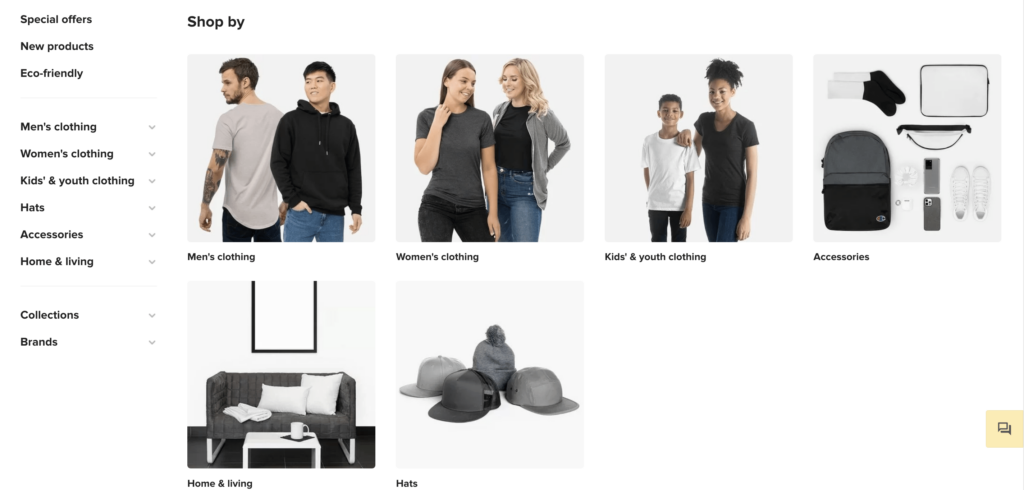
Here are some items that you may consider:
1. Apparel and Accessories:
One of the most popular choices for print-on-demand products on Etsy is custom apparel and accessories. This category includes T-shirts, hoodies, hats, and even socks that can be adorned with your designs or illustrations. Personalized apparel is a hit among Etsy shoppers who seek one-of-a-kind fashion statements. Besides, you should also consider niche markets or trending themes to make your products stand out.
2. Home Decor:
Transforming living spaces with personalized touches is a trend that continues to gain momentum. Print-on-demand home decor items like custom throw pillows, blankets, wall art, and even customized doormats can find a market on Etsy. You can tailor your designs to cater to specific home decor themes or seasonal trends to attract a diverse customer base.
3. Stationery and Paper Goods:
Etsy is a hub for all things crafty, and stationery is no exception. Offer personalized notebooks, journals, greeting cards, and planners that customers can customize with their names, quotes, or special dates. This category appeals to those who appreciate the art of writing and are on the lookout for unique paper goods.
4. Tech Accessories:
As technology becomes increasingly integrated into our daily lives, the demand for personalized tech accessories is on the rise. Print-on-demand phone cases, laptop sleeves, and even custom mouse pads allow Etsy sellers to tap into the tech-savvy market. Consider creating designs that align with popular culture, hobbies, or specific interests to attract a wide range of customers.
How to Start Selling With Print-on-Demand on Etsy?
Starting selling on Etsy is easy. We’ll show you how to set up a print-on-demand Etsy store in a few easy steps.
Step 1: Getting Started and Sell on Etsy
Before you can start selling on Etsy, you need to create an Etsy seller account. Here’s how:
- First, visit Etsy’s website: Go to www.etsy.com.
- Then, sign up for an Etsy Seller Account. Click on the “Sell on Etsy” option located at the top right corner of the homepage.
- Then, Fill out the registration form: Provide the required information, including your email address, password, and shop name. Your shop name should be unique and reflect your brand.
- Later, choose your shop preferences: Select your preferred language, country, and currency.
- Then, agree to Etsy’s terms: Carefully read and accept Etsy’s terms of use and seller policy.
- Finally, open your Etsy shop: Once your account is created, you can open your Etsy shop. Follow the prompts to set up your shop, including choosing your shop’s payment and shipping options.
Step 2: Planning Your Print-on-Demand Etsy Shop
Finding Your Niche
You should always start by considering what you’re passionate about creating. Whether it’s handcrafted jewellery, vintage clothing, personalised artwork, or any other product, your enthusiasm for your craft will shine through in your work and attract like-minded customers.
In the end, you are going to work long hours in the business. It will be very hard to continue if you are not interested or passionate about it.
While passion is crucial, it’s essential to ensure there is a demand for your chosen niche. You can use tools like Google Trends, Etsy’s search bar, or third-party market research tools to assess the popularity of your niche.
Also, look for trends and seasonality that may affect sales.
Finally, you need to know who you want to serve. You need to know who is your audience and who are your ideal customers. Overall, the more details you know about them better you can create the products that they want.
You can consider factors like age, gender, interests, and location. And then. tailoring your products and marketing efforts to your target audience can increase your shop’s appeal.
Researching the Competition to Sell on Etsy
Your competitors are your good teachers too. You can first, look at the top-selling shops within your niche. In addition, you can also study their product listings, pricing strategies, and customer reviews.
Take note of what seems to be working for them, but also look for gaps in their offerings that you can fill. You can create a swipe file of successful products and stores. And when you are creating your product, you can always refer to the swipe file.
Then, assess the price ranges of similar products. Are they high-end, mid-range, or budget-friendly? You need to determine where your products fit in and price them accordingly.
Be competitive enough to make sales, but at the same time ensure your prices cover production costs, marketing and platform costs and allow for a reasonable profit margin.
Finally, you need to give a reason for people to buy from you. This means you need to identify what makes your products unique. For example, it could be your design style, quality, customization options, or the story behind your creations.
Highlight your unique selling proposition in your product descriptions and shop branding. This will give people the push to buy from you.
Step 3: Creating and Gathering Your Product Listings
Product Photography
Your product image is the most important in your product page. Your customers will not touch your products. Product photography is the only way they know your product and decide to buy.
So, if possible, invest in a good camera or smartphone with a high-quality camera. Adequate lighting is crucial, so consider purchasing or creating a well-lit space for your product photography.
After getting the right equipment, you need to have a good background and place for your product photo. You don’t want a messy background for your product photo.
Instead, use a clean, clutter-free background that complements your product’s style. Neutral colours or textured surfaces work well. Avoid distracting backgrounds that take the focus away from your product.
When taking your product photo, you need to capture it from multiple angles. This will give customers a comprehensive view of the products from different angles. Finally, show close-ups of intricate details and any unique features.
Another type of product photo will be a lifestyle photo. You want to show them how the product looks in real life. When they can imagine using that product, it will be more relatable to them.
Finally, make sure to edit your photos to enhance brightness, contrast, and sharpness. There are various photo editing tools and apps available to help you achieve professional-looking images.
Writing Compelling Product Descriptions
Your product descriptions should provide all essential information while being engaging and compelling. Describe the item’s size, colour options, materials, and any customization choices.
In addition, you should highlight the key features and benefits of your product. Explain how it can solve a problem or enhance the buyer’s life. People don’t buy because of the specs of the product. They are buying it to solve a problem for them.
For them to resonate with the product, share the story behind the product, if applicable. This could include your creative process, inspiration, or the uniqueness of the materials used.
If possible, create a FAQ in your product description so your customer’s questions can be answered without them reaching out to your customer support.
Your product descriptions shall be easy to read as people used to scan through your product descriptions. To do this, you can use bullet points and clear headings to make the information easy to scan. In addition, a well-organized description is more likely to be read thoroughly.
Finally, your product visibility for Etsy relies much on Etsy SEO. Do good research for the relevant keywords and incorporate relevant keywords naturally into your descriptions to improve search visibility.
Step 4: Setting Up Your Print-on-Demand Etsy Shop
Branding is what differentiates your shop from others. You need to create unique branding for your shop. However, for Etsy, you are not able to design your store and product page yourself.
However, there are a few things that you can change for your store branding.
Shop Name and Banner
Your shop name should be unique, memorable, and reflective of your brand. You need to avoid overly complex or lengthy names that may be difficult for customers to remember or type. You can change your shop name later, but it’s best to select one that you plan to keep long-term.
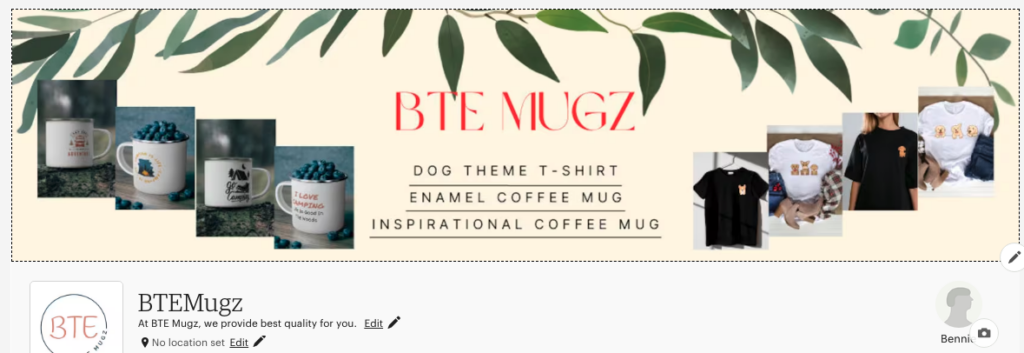
Your shop banner is the visual introduction to your store. It’s the first thing visitors see when they land on your shop’s homepage. Create a banner that represents your brand’s style, showcases your products, and sets the tone for the shopping experience.
Shop Policies
Shop policies are what protect you from disputes and legal issues.
You need to clearly outline your shipping policies, including estimated delivery times, shipping carriers used, and any additional services (e.g., tracking, insurance) you offer. There is a benefit here to being transparent about shipping costs, especially for international customers.
When you set the right shipping time expectations for the orders, your customers will not complain when they wait for a few days for the product to arrive.
It is normal to have returns and refunds for your business. This is even a requirement for selling in some countries. You need to specify your return and refund policies. Then, indicate whether you accept returns, under what conditions, and who bears the return shipping costs. Having clear policies reduces misunderstandings and disputes.
If you offer custom or personalized orders, explain the process, including how customers can request custom items and any additional costs or timeframes involved. Most importantly, you are not going to accept refunds or returns for customized orders if your customer changes their mind.
To collect your payment, you should provide different payment options. In your shop, provide the details of the payment methods you accept, such as credit cards, Etsy Payments, PayPal, etc.
Payment and Shipping
Etsy offers various payment options for sellers. Etsy Payments is a popular choice, allowing buyers to pay with credit and debit cards, PayPal, and other methods. Ensure your payment methods align with your target customer’s preferences.
Choose your shipping options, including domestic and international shipping. Consider offering free shipping or flat-rate shipping if it makes sense for your products. Calculate shipping costs accurately to avoid undercharging.
Specify your processing times, which indicate how long it takes to prepare an order for shipping. Be realistic and transparent about these times to manage customer expectations.
Etsy offers a convenient feature for purchasing shipping labels directly through the platform. This can save you time and potentially reduce shipping costs.
Shop Announcement
Your shop announcement is a dynamic section where you can share important information, promotions, updates, and announcements with visitors. Keep this section fresh and engaging to capture potential buyers’ attention.
You should use this space well to promote any upcoming events, sales, or product launches. It’s a great way to build anticipation and generate interest.
Consider incorporating relevant keywords into your shop announcement to improve its search visibility. However, ensure that it still reads naturally and engages visitors.
Step 5: How to Post New Listings on Etsy
Adding a New Listing
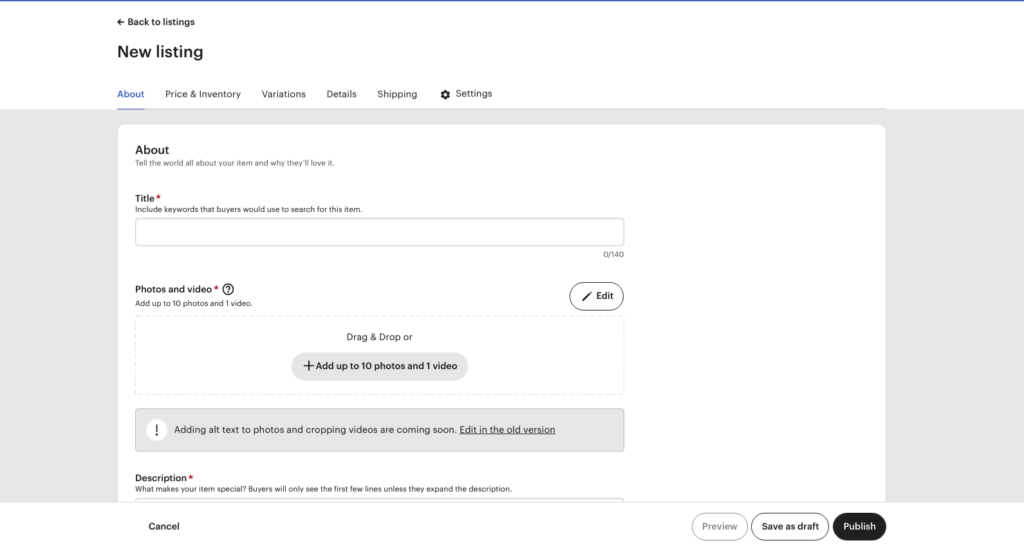
- First, Log in to your Etsy seller account if you’re not already signed in.
- Then, from your seller dashboard, click on “Shop Manager.”
- Next, under the Shop Manager menu, choose “Listings.”
- Finally, to create a new listing, click the “Add a listing” button.
Uploading Photos
- High-Quality Images: Prioritize high-quality product images. Ensure that your photos are well-lit and sharp, and showcase your products accurately.
- Multiple Angles: Capture your product from different angles to give potential buyers a comprehensive view.
- Editing: Use photo editing tools to enhance your images, adjusting brightness, contrast, and colour if necessary. Make sure your product’s colours are accurately represented.
- Lifestyle Shots: Include lifestyle shots if applicable. Show how your product can be used or worn in real-life scenarios.
Writing Titles and Descriptions
- Keyword Research: Research relevant keywords using Etsy’s search bar, Google Keyword Planner, or third-party keyword research tools. Then, incorporate these keywords naturally into your titles and descriptions.
- Engaging Titles: Craft engaging product titles that are concise and informative. You need to include key features and benefits. In addition, don’t forget to mention any unique selling points.
- Descriptive Descriptions: Write detailed and descriptive product descriptions that address potential buyer questions. Explain size, colour options, materials used, and any customization choices.
- Storytelling: If applicable, share the story behind your product, your creative process, or what makes it unique. Personal touches can create a connection with buyers.
- Formatting: Use formatting tools like bullet points and clear headings to make your description easy to read and scan.
- SEO Optimization: Optimize your listings for search by including relevant tags, attributes, and categories. Etsy’s search algorithm uses these to match your listings with potential buyers.
Setting Prices and Inventory
If your product comes in different sizes, colours, or styles, use Etsy’s variation feature to offer these options within a single listing. This simplifies the shopping experience for buyers.
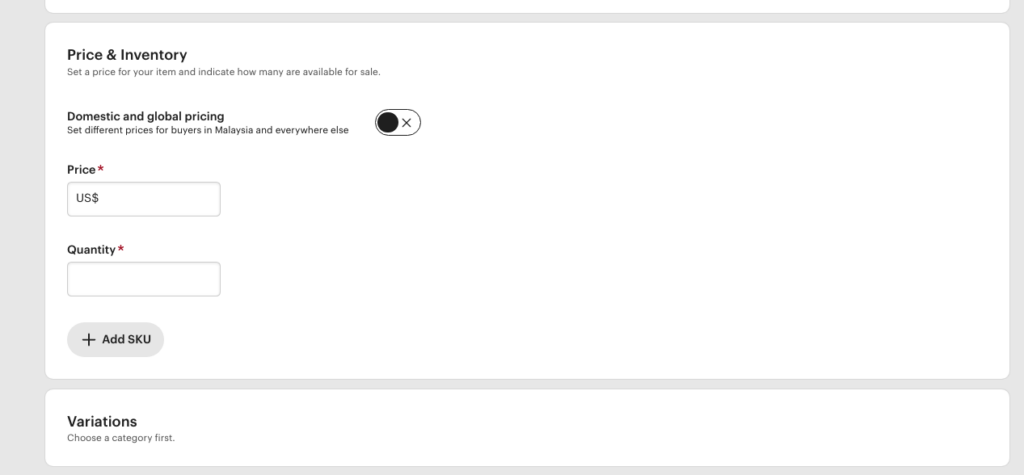
Then in the inventory management section, you need to update your listing’s inventory regularly to ensure that you will have enough stock to fulfil the order. Etsy provides tools to help you keep track of available quantities. This is important because if you are offering custom or made-to-order items, a longer lead time is required to restock them.
Finally on the listing renewal. All new Etsy listings will have a four-month active duration. After this period, you can then choose to renew them for a small fee of 20 cents.
So, make sure you keep track of listing expiration dates to ensure your products remain visible.
By setting up your Etsy shop effectively and mastering the art of posting listings, you’ll be well-prepared to showcase your products to potential buyers and start building a successful online business on the platform.
Step 6: Optimizing Your Etsy Listings
Etsy SEO is how you get visibility for your product listings on Etsy. You need to optimize your product listings based on Etsy’s search algorithm to show it up on the first page of the search result. When you are ranked, you will be getting traffic to your site.
Understanding Etsy’s Search Algorithm
Etsy uses a complex search algorithm to determine which listings appear at the top of search results. It takes into account factors like relevancy, listing quality, and customer behaviour. Therefore, understanding how this algorithm works is crucial for improving your listings’ visibility.
Keyword Research
Keyword research is an ongoing process. You need to then explore popular and trending keywords in your niche regularly. You need to look for long-tail keywords (more specific phrases) that potential buyers might use to find your products.
Using Relevant Tags and Attributes
Etsy allows you to add tags and attributes to your listings. Tags are descriptive keywords, while attributes provide specific details about your product (e.g., size, colour). Use these fields strategically to match your listings with search queries.
Monitoring and Adjusting
Use Etsy’s analytics tools to track how your listings are performing. Pay attention to which keywords and tags are driving traffic and sales. Adjust your listings based on this data to optimize your strategy.
Step 7: Promoting Your Etsy Shop
Social Media Marketing
Promote your Etsy shop on social media platforms like Instagram, Facebook, and Pinterest. Share high-quality images of your products, engage with your audience, and run targeted ads if your budget allows.
Etsy Advertising
Etsy offers paid advertising options to boost your listings’ visibility. You can set a daily budget and choose the listings you want to promote. Monitor your ad performance and adjust your strategy accordingly.
Collaborations and Partnerships
Consider collaborating with influencers or complementary Etsy shops to expand your reach. Partnerships can introduce your products to new audiences.
Customer Engagement
Engage with your customers through email newsletters, updates, and promotions. Building a loyal customer base can lead to repeat business and referrals.
How to Get Your First Print-On-Demand Sales on Etsy
Now that you already created your Etsy store with your POD platform integrated, and then decided which product to sell. Now, it’s time to see how to get your first sale and build your business empire on Etsy.
To get sales on Etsy, your products need to be shown to potential buyers. The more visibility you get, the more potential sales you will get. And we call this Etsy SEO. There are a few things that will affect the ranking.
Product Photos and Descriptions – Print-On-Demand Sales on Etsy
To sell something online, the first impression will be your product photos and descriptions. People are not looking or touching at the actual products. So their buying decision will be solely based on how the product looks in the product photos and also the descriptions.
Not only that, when you search for a product on Etsy, the first thing you will see is the product thumbnails. So, before even reading the product title, you will click on the product listing based on the attractiveness of the product thumbnails.
Not only that, having professional product photos will give a good impression to your customers showing that you are a trusted seller. Besides, you may have some clickbait elements on your product photos to stand out from other listings and make sure people will be attracted and click on your product listings.
You can always use a mockup like Placeit or Canva to create your thumbnail. There are many mockup templates available for you to customize and create your attractive product photos.
After they click on your product listings, it’s time for your product descriptions to persuade them to buy. We call this the sales copy. In your product descriptions, you should explain the benefits of the product to your potential customers. And at the same time, manage their expectations by sharing your shipping policies and your shop terms. This will avoid disputes or refunds.
In your descriptions, you should also include some popular keywords so that it may help in your Etsy search ranking as well.
Increase your Etsy SEO Ranking – Print-On-Demand Sales on Etsy
Etsy is a huge marketplace. There are many products sold on the platform. The best way to get visibility is to get on the top of the search results. For Etsy to show your product on the first page or the first few rows, you need to make your product easy to search on Etsy. This means knowing what people are searching for and optimising your listings to rank higher on Etsy search results. We call this the Etsy SEO strategy.

We will briefly share the 4 important elements for Etsy SEO to rank. For a more detailed guide, you may check our complete Etsy SEO guide.
1. Title
ON Etsy, there is a word limitation of 140 characters for your title. However, the search engine algorithm will put more weight on the first few words. So, when writing your Etsy title, focus on the first few words first.
Don’t repeat words in the title and avoid keyword stuffing. Your title has to make sense and still contain all the crucial keywords.
Etsy doesn’t allow titles to contain more than 3 words in all caps. Some special characters like the percentage symbol (%) and ampersand (&) can only be used once, and the dollar sign ($) and caret (^) aren’t allowed at all. So, think carefully about which three words are best suited to describe your product.
2. Etsy tags
As far as Etsy tags are concerned, they have two roles. To help Etsy buyers find similar products to the one they are looking for and to help Etsy’s algorithm with the query matching process.
Etsy lets you add up to 13 tags for each listing. So you better make good use of all of it. Your tags can cover a wide range of terms so you can get ranked for more keywords.
Not only that, Etsy allows up to 20 characters for each tag and it can contain multiple words. This means you should use multi-word tags to get a more precise keyword tag.
Another pro-tip. You should focus more on long-tail keywords than standard keywords. This is because people will search for specific terms for what they want. Also, long tail keywords tend to be easier to rank with lesser competition than a generic term as not many people will focus on ranking it.
3. Attributes
Attributes are the additional details you use to describe your products. They’re displayed on the left side of the search results page for customers to filter what they want to view.
You can include as many attributes as possible in your listings and use that to broaden the match potential of your listing.
4. Categories
Start with your category and then narrow it down to the sub-category so it will be easier for Etsy to show your products in the different related categories.
To ease product searching, Etsy groups different products in each category so it will be easier for us to search based on the category they want. And if you can group your product listings in the right category, it will help people to view your product.
Offer Product Personalization – Print-On-Demand Sales on Etsy
Personalization is a very popular product type on Etsy. People are selling personalized gifts on Etsy for different occasions and festive seasons.
Printful offers customized personalization products for your Etsy store. In your Etsy store, enable the personalization section on your store and then head to Printful Dashboard and watch the personalised orders appear, ready for editing.
Offer Free Shipping – Print-On-Demand Sales on Etsy
You might think that the shipping charge is not important. You are wrong. Having the right shipping strategy will help in a few ways. First of all, customer buying psychology does not favour a shipping charge. They can buy a few hundred dollars in your shop. But not willing to pay for a $4.99 shipping cost.
They will think that it should be free since they already made a huge purchase. Not only that:
A product with a price of $10 and a shipping cost of $4.99 is different from a $14.99 product with free shipping. Although they are getting the same product at the same price, the user experience is different. They will appreciate the free shipping offered.
You are not losing anything by doing this. Your revenue for each product is still the same. But this act will boost your sales as it is more likely for them to buy from you. Not only that, but Etsy also favours free shipping.
Etsy SEO for Free Shipping – Print-On-Demand Sales on Etsy
The Etsy SEO algorithm will rank products with low shipping or free shipping higher. This is especially useful for retailers and shoppers based in the US. You can have different shipping options for your products. For example, if you are focusing on the US market, you can offer free shipping for US buyers. This is a feature by Etsy for US buyers. When they purchase over $35 in a single order, they will be entitled to free shipping.
So, you should include the shipping cost in your product price and offer free shipping.
When using free shipping, make sure that you do your calculations well and don’t lose money by offering free shipping. Cover your shipping cost in your product price to offer free shipping, but not to earn more on this. You don’t want to give your customers the impression that you are charging too high.
Know Your Numbers – Print-On-Demand Sales on Etsy
When you are selling online or doing any digital marketing, data analysis is the most important to know what’s working and what’s not. Also, knowing what you can optimize in your product listings or marketing strategy.
Etsy provides excellent reporting features in the Etsy Stats Tool to show where your Etsy shop traffic comes from and what keyword they are searching to reach your product listing. You can use this information to optimize your title, description and tags to focus on those keywords.
In your Etsy Shop Manager, in the Stats section, you can see which listings are not getting views, and you should optimize the listing to get a better rank.
Testimonials & Review – Print-On-Demand Sales on Etsy
Testimonials and reviews are the very important things that you need to grow and boost your sales. When you are starting, your store will be empty without any reviews. But when you are getting sales, you can message your customers to let them give a review on their purchase.
This is a good way to interact with your customers and build relationships with them so they can come back to buy again. However, don’t offer any incentive in the message to get them to leave a review. This can lead to a violation of Etsy terms.
How to Start a Print-On-Demand Business on Etsy: Closing Thoughts
Starting your print-on-demand business on Etsy is easy and you can start selling your print-on-demand products on Etsy within clicks.
With our detailed step-by-step guide and exclusive tips, you can also start your business today. However, you will need to continuously optimize your store and listings to get the winning product that your customers want.
